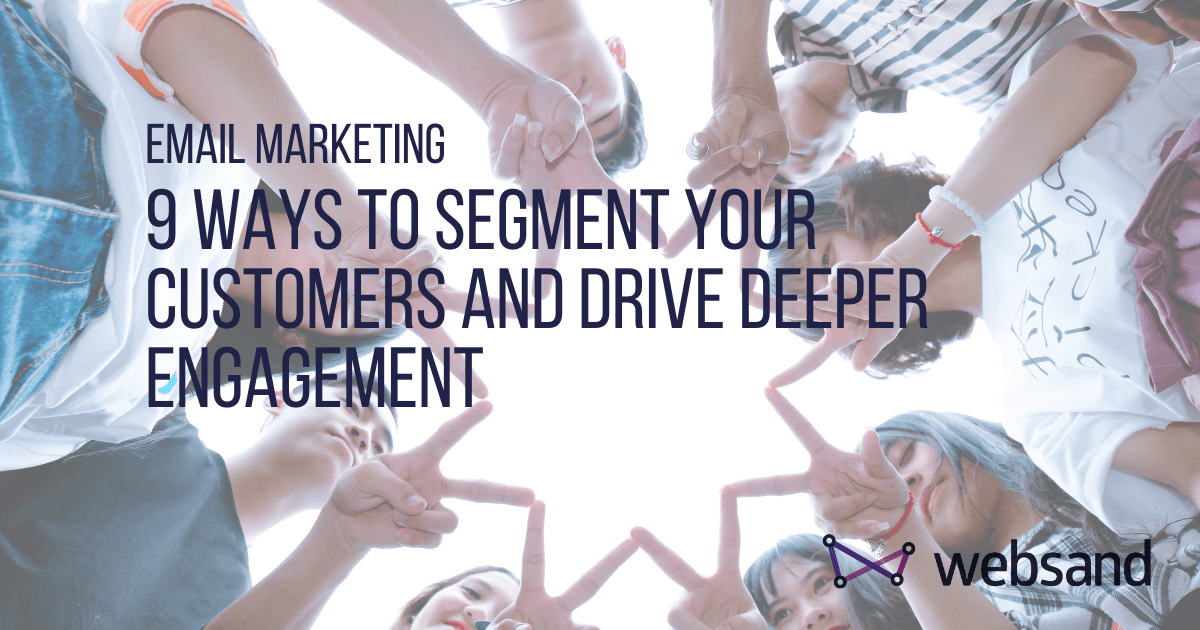Why segment your customers?
People are different but they share similar behaviour and profiles. So if you really want to understand what’s going on in your business you need to segment your customers.
Segmentation allows you to see your business from a different viewpoint. Helping you make key decisions and get the most from the customer data your business collects.
Most businesses analyse their performance using traditional means such as number of sales, profit and loss.
These reports give you an overview of business performance, but diving a little deeper using segmentation can help you to really understand the value and trends that underpin your top line business performance.

As well as helping understanding business performance, and identifying new opportunities; customer segmentation also provides a great foundation for more effective marketing.
Using customer segmentation software, such as Websand, the possibilities are endless.
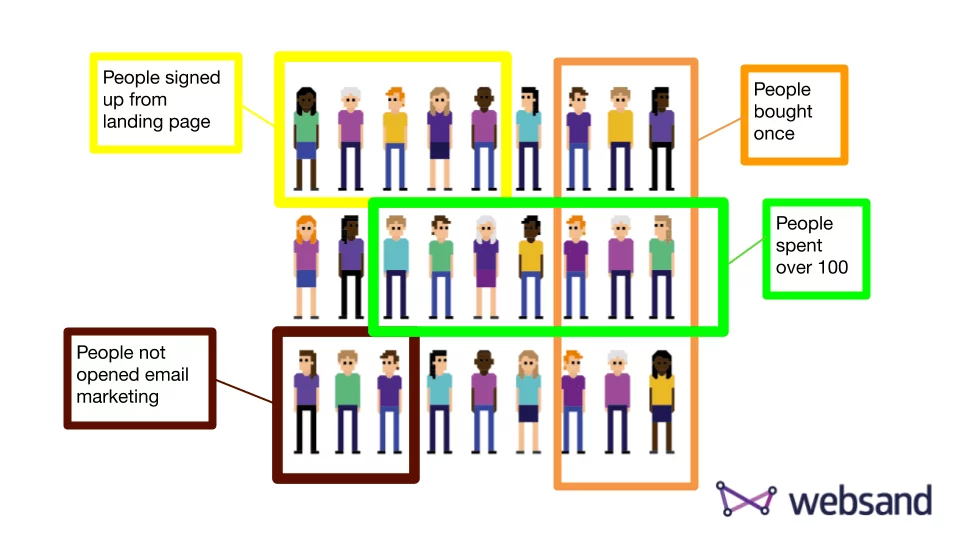
However it’s always best to start simple, and segment your customers in line with your business strategy or key challenges that you want to explore further.
Nine segmentation strategies to grow your business
You are collecting data every day, so managing this data strategically is important. Finding the right approach to segmentation can help your business grow, and fast.
Here are nine different approaches to segmentation to help you get your segmentation strategy started.
1) Segmentation by Customer lifetime value
My background is in building loyalty programmes so I make no excuse to put this top of this list.
Understanding the customer lifetime value of each of your customers gives you a great insight to value created by each of your customers.
Segment your customers based on the average value of each customer – and bingo! You’ve identified who your most important customers really are!
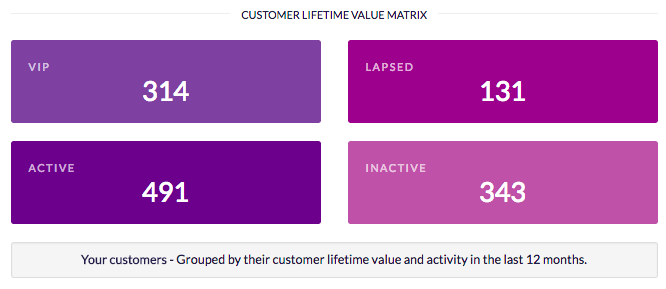
The above table segments based on the time of last purchase and the lifetime value of each customer. To explain the segments in more details
- VIPs segment contains customers with above average customer lifetime value and purchased within last 12 months.
- Lapsed segment contains customers with above average customer lifetime value, but have not purchased within last 12 months.
- Active segment contains customers with below average customer lifetime value and purchased within last 12 months.
- Inactive segment contains customers with below average customer lifetime value, but have not purchased within last 12 months.
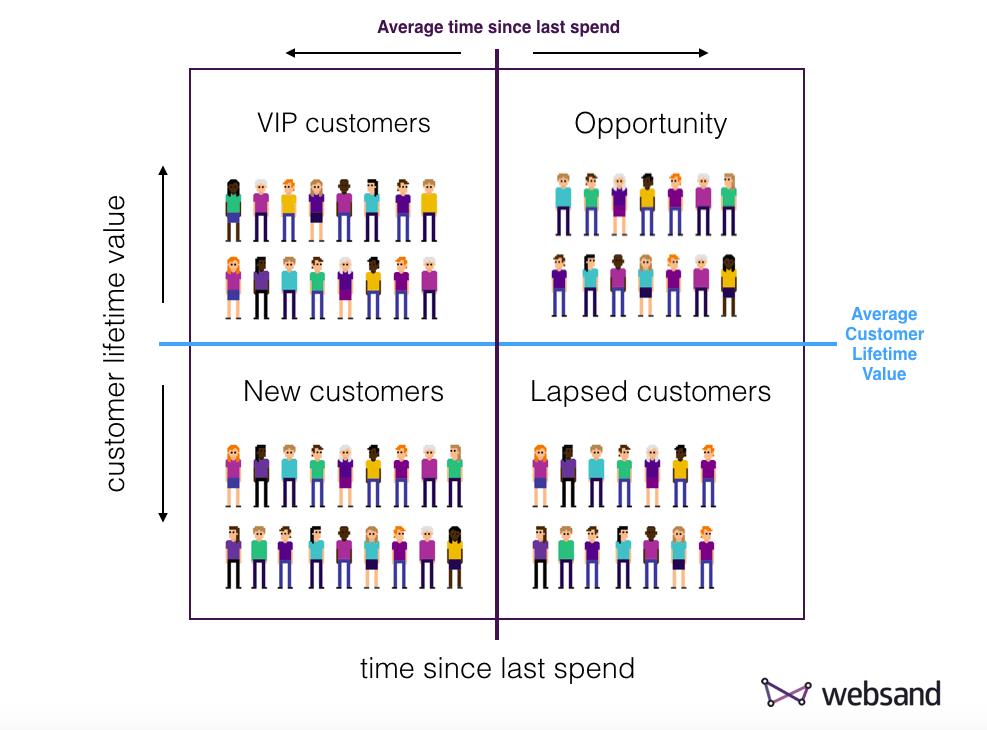
Understanding your customers based on how much they’ve spent makes it much easier to create targeted marketing programmes. The segments are based on the value of the relationship with each customer, so it’s easy to work out where to invest time and effort to get the best results.
2) Segmentation based on date of last purchase.
Customer churn is a term used to define the number of customers that have ‘left’ your business.
You put all that effort into getting customers through your sales process and then what? Do you have a measure that defines when a customer is no longer a customers? Is it 4 months since the last purchase? Is it a year?
Segment your customers based on the last time they purchased from you, and you’ve got the starting point to manage your customer retention and reduce customer churn.
Managing customer churn is as important as managing your sales process.
Getting it right can unlock huge growth for your business at a fifth of the signing up a new customer.
3) Segmentation based on purchase frequency
When is a customer really a customer? Is it really one purchase? I’d define a customer as a person or business that regularly purchases from your business.
Based on that definition – when is a customer really a customer for your business. Is it one, two, three or even four purchases?
Segment your customers based on the number of purchases they have made with you, and you’ll get a deeper understanding of what the real purchase frequency looks like within your customers. You’ll soon spot where you need to focus marketing activity.
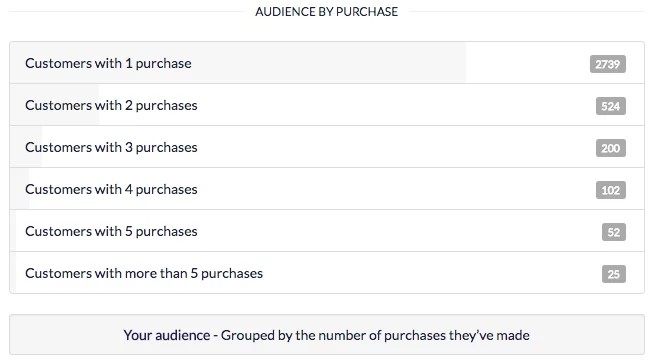
The table above is a typical example from an ecommerce business. Marketing focus tends to be on ‘prospect’ conversion rather than customer retention. As a result, the drop off from 1 purchase to more than one purchase is typically around 80%.
Segmenting your customers based on those people that have only bought once is the first step, the next stage is to design a marketing programme to encourage them to buy from you again the next time.
4) Segmentation based on purchase history.
Sales reports show the volume of products and services that are bought. Segmentation can show you the people that have bought the products and services that you offer.
The reports will not be the same, and this segmentation can give you great insight to develop cross selling and upselling activity based on the behaviour of people with the same profile – “other people that have bought (X) also bought this (Y)”.
If you could identify this, and segment your customers based on what they’ve bought, would this change your marketing activity?
5) Segmenting your Customer lifecycle
The customer lifecycle refers to the behaviour of a customer – after purchase (sales funnel would be before purchase), this is also known as a customer journey.
If you have a specific process that customers typically follow – or that you want them to follow – such as moving from one purchase to the next or upselling a specific service.
For example, O2 want their customers to use Priority Moments because they know that if a customer uses Priority Moments over 5 times they are far more likely to renew with O2 than with a rival mobile provider.
Segment your customers for each point of your customer journey and you’ll soon understand how effective you are at managing your customer lifecycle.
6) Segmentation to manage your Sales funnel
Segmentation within the sales funnel is probably the most common use of segmentation as it is the basis of nearly every CRM.
Using segmentation it’s easy to understand how many potential sales exist at each point of the process.
Great for sales performance measurement and also to support marketing activity to ‘nurture’ prospects through the sales process.
7) Segment to identify opportunities within your Product lifecycle
Unfortunately, nothing lasts forever. Every product or service has a duration. For a subscription business, this is relatively easy to communicate to customers and internally as each customer has a ‘renewal date’.
The same concept can be applied to every product or service that is sold to a customer.
For example, if you are selling business cards, the data you hold on repeat purchases from existing customers could be used to identify when a customer is likely to buy business cards in the future.
Segment your customers based on purchase can help drive marketing activity through marketing automation as well as adding extra insight to your business planning (stock / orders).
8) Segment to understand the most effective sources of Acquisition
Where have all of your customers come from? This is data that is often captured but rarely used.
Segment your customers based on ‘where’ they came from, gives a long term view on how effective your inbound marketing activity has been.
If you want to be really clever, then segmentation by customer lifetime value and source of acquisition will give you an easy ROI measurement for your inbound marketing spend – and that is really useful.
9) Segment to understand your Marketing effectiveness
Segmentation can help you to understand how effective your marketing activity has been.
Segment your customers based on their responses to different marketing activity – for example for email – ‘opens’, ‘clicks’, and ‘non-opens’ allows you to understand how customers react to different marketing channels.
If you want to be really clever, then segmentation by customer spend and marketing campaign will give you an easy ROI measurement for your marketing campaigns – saving you a lot of time and effort
Getting started. Putting customer segmentation in play
We’ve listed nine different types of segmentation to get your planning started. However, to be really effective, segmentation should be dynamic. That way your data is always managed in the way you need, when you need it.
Websand allows you to apply all of the segmentation strategies described in this blog post and also gives you the mechanism to drive marketing activity based on your segmentation strategy through marketing automation.
If you are looking for support to put any of the strategies described above into your business, sign up below or click here to schedule a call and we’ll arrange a chat.
It’s time to start getting more from your email marketing
Sign up for a free Websand demo and let’s show you how to get the best from your email marketing.
